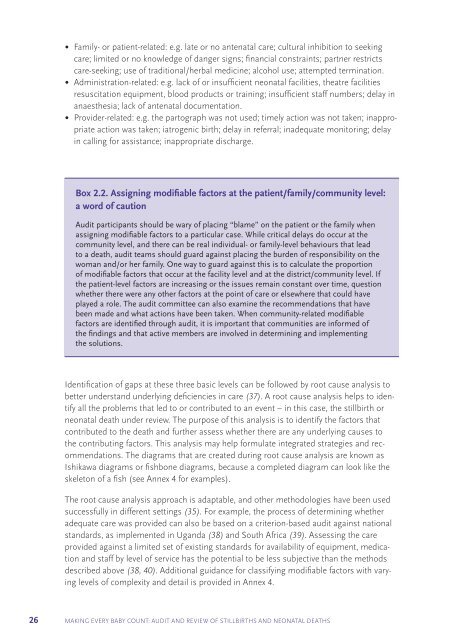Making Every Baby Count
9789241511223-eng
9789241511223-eng
You also want an ePaper? Increase the reach of your titles
YUMPU automatically turns print PDFs into web optimized ePapers that Google loves.
• Family- or patient-related: e.g. late or no antenatal care; cultural inhibition to seeking<br />
care; limited or no knowledge of danger signs; financial constraints; partner restricts<br />
care-seeking; use of traditional/herbal medicine; alcohol use; attempted termination.<br />
• Administration-related: e.g. lack of or insufficient neonatal facilities, theatre facilities<br />
resuscitation equipment, blood products or training; insufficient staff numbers; delay in<br />
anaesthesia; lack of antenatal documentation.<br />
• Provider-related: e.g. the partograph was not used; timely action was not taken; inappropriate<br />
action was taken; iatrogenic birth; delay in referral; inadequate monitoring; delay<br />
in calling for assistance; inappropriate discharge.<br />
Box 2.2. Assigning modifiable factors at the patient/family/community level:<br />
a word of caution<br />
Audit participants should be wary of placing “blame” on the patient or the family when<br />
assigning modifiable factors to a particular case. While critical delays do occur at the<br />
community level, and there can be real individual- or family-level behaviours that lead<br />
to a death, audit teams should guard against placing the burden of responsibility on the<br />
woman and/or her family. One way to guard against this is to calculate the proportion<br />
of modifiable factors that occur at the facility level and at the district/community level. If<br />
the patient-level factors are increasing or the issues remain constant over time, question<br />
whether there were any other factors at the point of care or elsewhere that could have<br />
played a role. The audit committee can also examine the recommendations that have<br />
been made and what actions have been taken. When community-related modifiable<br />
factors are identified through audit, it is important that communities are informed of<br />
the findings and that active members are involved in determining and implementing<br />
the solutions.<br />
Identification of gaps at these three basic levels can be followed by root cause analysis to<br />
better understand underlying deficiencies in care (37). A root cause analysis helps to identify<br />
all the problems that led to or contributed to an event – in this case, the stillbirth or<br />
neonatal death under review. The purpose of this analysis is to identify the factors that<br />
contributed to the death and further assess whether there are any underlying causes to<br />
the contributing factors. This analysis may help formulate integrated strategies and recommendations.<br />
The diagrams that are created during root cause analysis are known as<br />
Ishikawa diagrams or fishbone diagrams, because a completed diagram can look like the<br />
skeleton of a fish (see Annex 4 for examples).<br />
The root cause analysis approach is adaptable, and other methodologies have been used<br />
successfully in different settings (35). For example, the process of determining whether<br />
adequate care was provided can also be based on a criterion-based audit against national<br />
standards, as implemented in Uganda (38) and South Africa (39). Assessing the care<br />
provided against a limited set of existing standards for availability of equipment, medication<br />
and staff by level of service has the potential to be less subjective than the methods<br />
described above (38, 40). Additional guidance for classifying modifiable factors with varying<br />
levels of complexity and detail is provided in Annex 4.<br />
26 MAKING EVERY BABY COUNT: AUDIT AND REVIEW OF STILLBIRTHS AND NEONATAL DEATHS
















